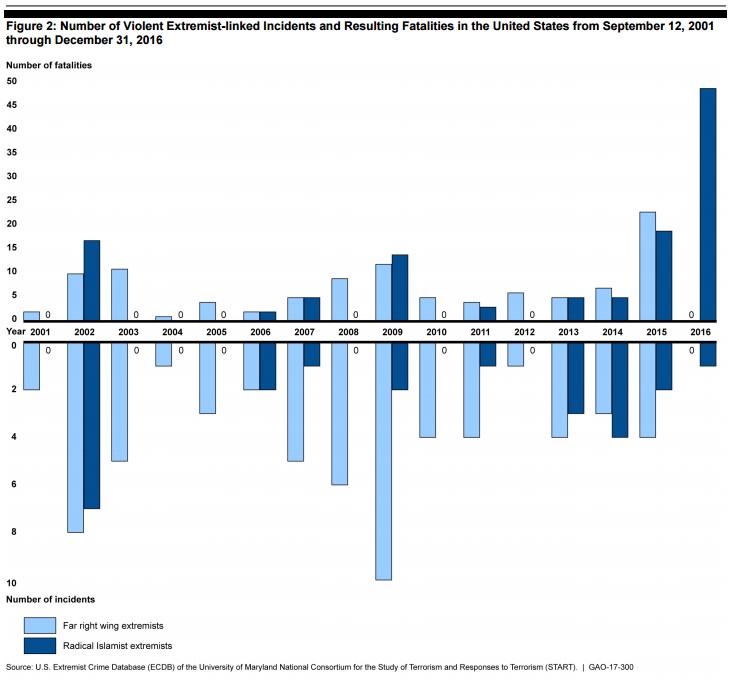Since 9/11, almost as many Americans have died at the hands of far-right-wing extremists as have been killed by radical Islamists – 106 and 119, respectively – a new report by the nonpartisan Government Accounting Office shows.
The GAO also said that despite more than $50 million being spent by the Dept. of Homeland Security (DHS) in 2016 to counter the growth of violent extremism in the U.S., there is no mechanism in place to measure whether efforts apart from surveillance and law enforcement have been effective.
Related: Main Suspect in Stockholm Truck Attack Admits to Terrorist Crime
Of the 85 violent extremist attacks since Sept. 12, 2001, which resulted in 225 deaths, 62 – or 73 percent – were by far-right groups or individuals, the GAO report says.
While more of the 225 deaths were attributed to radical Islamists, the GAO said that 41 percent of those killings happened in a single incident, the 2016 attack on a club in Orlando. The shootings at the Pulse nightclub left 49 dead and 53 wounded.
The sole perpetrator of the Pulse attack – the deadliest mass shooting in U.S. history – was an American-born security guard of Afghani origins named Omar Mateen who is said to have pledged his allegiance to ISIS. But some reports have said Mateen was seen at the largely gay club on many occasions and have suggested that the incident may also have been a hate crime. Still, mass murder is the signature of radical Islamist terrorism.
Also tagged as the work of radical Islamists were the 2002 “Beltway Sniper” shootings in which 10 people were shot to death in Washington, Virginia and Maryland, though the motives of the main killer remain murky. What is not measured in the report can terrorize people and have a long-lasting impact on society, even though it might not have resulted in a multitude of deaths. That would include the Boston Marathon bombing, where three people died, and 16 people lost their limbs.
Related: Trump Says ‘Thousands of Shooters’ Like Orlando Terrorist Are in the US Already
The GAO defines violent extremism as “ideologically, religious, or politically- motivated acts of violence” that have been “perpetrated in the United States by white supremacists, anti-government groups, and radical Islamist entities, among others.”
In 2011, the government set out to devise strategies that would “address the conditions and reduce the factors that most likely contribute to recruitment and radicalization by violent extremists” of any stripe. Some 44 tasks for countering violent extremism (CVE) were set, centering on community outreach, blunting recruitment messages and supporting local efforts to identify and counsel people at risk of being radicalized.
While about half of those tasks have been completed, another half are in progress, including “DHS building relationships with the social media industry and increasing training available to communities to counter violent extremists online.” Tasks not yet addressed include “implementing CVE activities in prisons and learning from former violent extremists.”

However, the report said that Washington has no mechanism for figuring out whether such attempts efforts at CVE have been effective.
Related: We Won’t Ever Stop Terrorism, but Let’s Be Honest About How to Reduce It
“We tried but were unable to come up with CVE funding levels. That’s largely because agencies have been using existing programs to address CVE goals. For example, programs or portions of programs to address violence in schools could be relevant to CVE, but you can’t specifically break out the ‘CVE only’ portion,” Diana Maurer, director of the GAO’s Homeland Security and Justice Team, said in an email
Because of that, the GAO report said it “was not able to determine if the United States is better off today than it was in 2011” in fighting back against the radicalization of individuals.
In 2016, $51.3 million was allocated for countering violent extremism by DHS, but there are no hard numbers for how much in total has been spent by all agencies in the years since the goals were set.
Broadly speaking though, Maurer said, it is fair to say that funding for federal CVE efforts to educate and prevent criminal or terrorist acts before they happen “is substantially less than the billions spent each year on federal efforts to counter or combat terrorism” by collecting evidence and making arrests. “GAO does not have a position on the relative allocation of resources, nor do we have a complete figure for the costs of combating terrorism,” she said.





